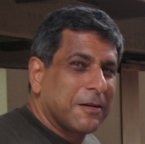Adi Bulsara
Appearance
Adi Bulsara | |
|---|---|
 | |
| Born | 15 May 1951 Bombay, India |
| Nationality | American |
| Alma mater | University of Texas at Austin |
| Known for | Nonlinear dynamics |
| Scientific career | |
| Fields | Physicist |
| Institutions | SPAWAR |
| Doctoral advisor | Ilya Prigogine |
Ardeshir "Adi" Ratan Bulsara (born 15 May 1951[1][2]) is a scientist in the area nonlinear dynamics. The 2007 International Conference on Applied Nonlinear Dynamics (ICAND), held in Kauai, Hawaii, was a festschrift held in his honor of his 55th birthday.[3]
Honours
[edit]In 2004, Bulsara was elected to Fellow of the American Physical Society (APS) for "developing the statistical mechanics of noisy nonlinear dynamical oscillators especially in the theory, application and technology of stochastic resonance detectors."[4][5] His festschrift in honor of his 55th birthday, which, for logistic reasons, was held when he was 56.[citation needed]
Books by Bulsara
[edit]- S. Baglio and A. Bulsara, (editors) Device Applications of Nonlinear Dynamics, Springer-Verlag, Berlin, 2006, ISBN 3-540-33877-2
- A. Bulsara, Noise and Chaos in the RF SQUID, Office of Naval Research, 1992, ASIN B0006R2M5I
- A. Bulsara, Coupled Neural-Dendritic Processes: Cooperative Stochastic Effects and the Analysis of Spike Trains, Office of Naval Research, 1994, ASIN B0006R2O9C
- J. B. Kadtke and A. Bulsara, (editors) Applied Nonlinear Dynamics and Stochastic Systems Near the Millen[n]ium, 411, San Diego, CA, American Institute of Physics, Woodbury, N.Y., 1997, ISBN 1563967367
References
[edit]- ^ Adi Ratan Bulsara, Entropy, Stability and Fluctuations in Lasing Systems, PhD Thesis, University of Texas at Austin, 1978
- ^ "Public Records & Background Checks – USSearch.com". Retrieved 22 April 2015.[permanent dead link]
- ^ Longhini. "ICAND 2007". Archived from the original on 7 May 2015. Retrieved 22 April 2015.
- ^ "APS Physics – GSNP – APS Fellowship". Retrieved 22 April 2015.
- ^ "APS Announces Spring 2005 Prize and Award Recipients" (PDF). American Physical Society. Spring 2005. p. 6. Retrieved 9 September 2018.
External links
[edit]- Adi Bulsara at the Mathematics Genealogy Project
- Photo of Bulsara in a high school debate, 1966[permanent dead link]
- Bulsara's publications at SPAWAR
- Bulsara page Archived 4 February 2008 at the Wayback Machine
- Humorous tribute to Bulsara
- Article on Bulsara's research
- Reference to Bulsara's work in New Scientist
- Bulsara's Physics Today article[permanent dead link]
- Reference to Bulsara's thesis
- Bulsara's biography at Campion
Categories:
- 1951 births
- Living people
- University of Texas at Austin College of Natural Sciences alumni
- People from San Diego
- Scientists from Mumbai
- Fellows of the American Physical Society
- 21st-century American physicists
- American people of Parsi descent
- American Zoroastrians
- Probability theorists
- Parsi people
- Parsi people from Mumbai
- Scientists from California
